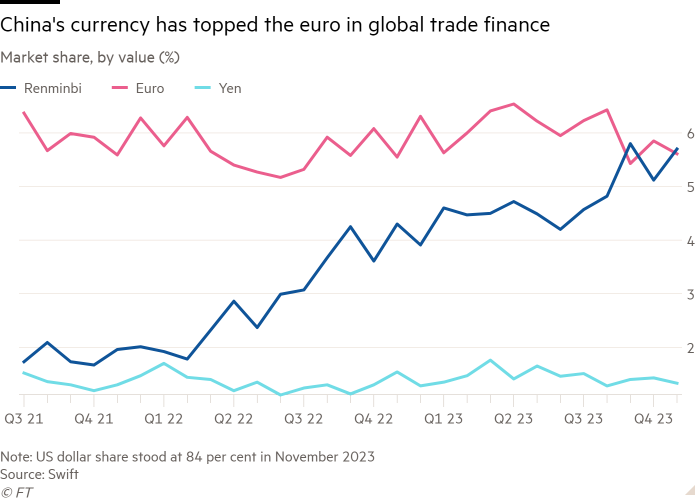Stay informed with free updates
Simply sign up to the Foreign exchange myFT Digest — delivered directly to your inbox.
The renminbi has surpassed the yen’s share of global payment transactions for the first time in almost two years, as low interest rates in China boost the appeal of its currency for financing trade with the world’s second-largest economy.
Figures released on Wednesday by international payments platform Swift showed the renminbi’s share of global payments had climbed to 4.6 per cent in November, up from 3.6 per cent a month before. It surpassed the yen for the first time since January 2022 to become the fourth most-used global currency behind the pound sterling, euro and US dollar.
The renminbi has been among the worst-performing global currencies this year, falling about 3.5 per cent to Rmb7.15 against the dollar in the face of sluggish Chinese growth and concerns over a liquidity crisis in the country’s property sector.
Analysts said the renminbi’s latest global payments gains were likely to be welcomed by Beijing, which is keen to increase the currency’s international profile as part of a broader drive to mitigate the risk posed to China by the US dollar’s longtime dominance of global finance.
Chi Lo, senior Asia-Pacific strategist at BNP Paribas Asset Management, said there had been a steady string of positive developments favouring the renminbi’s international use this year and that November’s readings “may even be the start of a slowly rising trend for the renminbi’s share of Swift [payments]”.
Economists said the latest rise was in large part due to lower Chinese interest rates which, while driving foreign investor outflows from the country’s onshore bond market, have also made the currency more competitive in the realm of trade finance. China’s benchmark one-year loan prime rate currently stands at 3.45 per cent, while the floor for the US federal funds rate is 5.25 per cent.
The attraction of lower Chinese rates is reflected in Swift figures tracking the renminbi’s share of trade finance, which rose to 5.7 per cent in November, up from 5.1 per cent the previous month. That pushed the currency to second place just above the euro, which had dropped below the renminbi for the first time in September.
Both currencies still badly lag behind the dollar, which accounts for more than 80 per cent of the global trade financing market.

“The underlying dynamics for trade finance have been changing in recent months as renminbi interest rates have edged lower,” said Kelvin Lau, senior economist for greater China at Standard Chartered.
With China’s central bank leaning towards looser monetary policy while western central banks kept rates elevated, Lau said the cost of financing trade with renminbi had dropped far enough to become attractive for some trading partners.
“This new phenomenon of the renminbi being seen as a low interest rate currency opens up the door for China’s currency to play a bigger role in trade finance,” he added.
The case for greater use of the renminbi in global payments — particularly through channels that bypass Swift — has also been bolstered by western sanctions on countries including Russia, which have put other economies on edge over the possibility of wider weaponisation of the dollar.
“The acceleration of payments in renminbi is partly a reflection of the geopolitical situation we’re seeing,” Mansoor Mohi-uddin, chief economist at Bank of Singapore, said. “That and long-term trends in trade flows may be accelerating the uptake of China’s currency.”
Carlos Casanova, senior economist for Asia at UBP, said: “Russia is not 100 per cent of the story. We also see an increase in settlements within Asia and with other economies that have high dependency on Chinese demand.”
Credit: Source link











